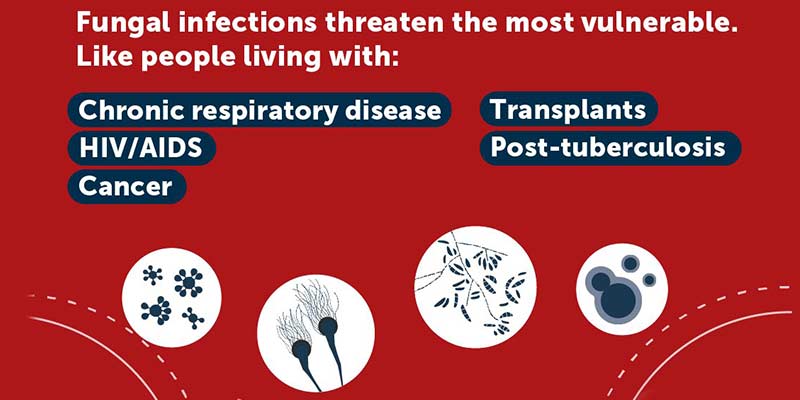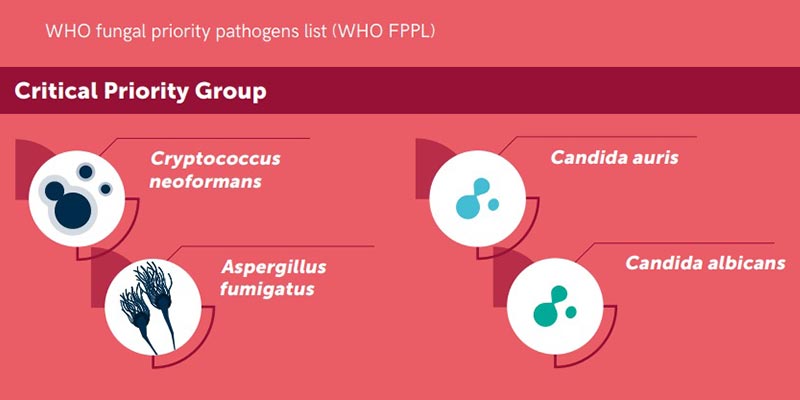- World
- Oct 29
WHO releases first-ever fungal priority pathogens list
WHO published a report highlighting the first-ever list of fungal priority pathogens — a catalogue of the 19 fungi that represent the greatest threat to public health.
The WHO fungal priority pathogens list (FPPL) is the first global effort to systematically prioritise fungal pathogens, considering the unmet research and development (R&D) needs and the perceived public health importance.
Significance of WHO fungal priority pathogens list
• Infectious diseases are among the top causes of mortality and a leading cause of disability worldwide. Drug-resistant bacterial infections are estimated to directly cause 1.27 million deaths and to contribute to approximately 4.95 million deaths every year, with the greatest burden in resource-limited settings.
• Against the backdrop of this major global health threat, invasive fungal diseases (IFDs) are rising overall and particularly among immuno-compromised populations. The diagnosis and treatment of IFDs are challenged by limited access to quality diagnostics and treatment as well as emergence of anti-fungal resistance in many settings.
• Despite the growing concern, fungal infections receive very little attention and resources, leading to a scarcity of quality data on fungal disease distribution and anti-fungal resistance patterns. As a result, the exact burden of fungal diseases and anti-fungal resistance are unknown, and the response is therefore undermined.
• Anti-fungal resistance has major implications for human health. It generally leads to prolonged therapy and hospital stays, and an increased need for expensive and often highly toxic second line anti-fungal medicines.
• In 2017, WHO developed its first bacterial priority pathogens list (WHO BPPL) in the context of increasing antibacterial resistance to help galvanize global action, including the research and development (R&D) of new treatments. Inspired by the BPPL, WHO has now developed the first fungal priority pathogens list (WHO FPPL).
• The WHO FPPL is the first global effort to systematically prioritise fungal pathogens, considering their unmet R&D needs and perceived public health importance.
• The WHO FPPL aims to focus and drive further research and policy interventions to strengthen the global response to fungal infections and antifungal resistance.
• The invasive forms of these fungal infections often affect severely ill patients and those with significant underlying immune system related conditions.
• Populations at greatest risk of invasive fungal infections include those with cancer, HIV/AIDS, organ transplants, chronic respiratory disease, and post-primary tuberculosis infection.
• Emerging evidence indicates that the incidence and geographic range of fungal diseases are both expanding worldwide due to global warming and the increase of international travel and trade.
• During the COVID-19 pandemic, the reported incidence of invasive fungal infections increased significantly among hospitalised patients.
• As the fungi that cause common infections (such as candida oral and vaginal thrush) become increasingly resistant to treatment, risks for the development of more invasive forms of infections in the general population are also growing.
Three priority categories
The WHO FPPL list is divided into three categories: critical, high and medium priority.
The fungal pathogens in each priority category are ranked primarily due to their public health impact and/or emerging antifungal resistance risk.
The critical group includes:
• Cryptococcus neoformans
• Candida auris
• Aspergillus fumigatus
• Candida albicans.
The high group includes:
• Nakaseomyces glabrata (Candida glabrata)
• Histoplasma spp.
• Eumycetoma causative agents
• Mucorales
• Fusarium spp.
• Candida tropicalis
• Candida parapsilosis.
Finally, pathogens in the medium group are:
• Scedosporium spp.
• Lomentospora prolificans
• Coccidioides spp.
• Pichia kudriavzeveii (Candida krusei)
• Cryptococcus gattii
• Talaromyces marneffei
• Pneumocystis jirovecii
• Paracoccidioides spp.
While recognising these critical pathogens as of public health concern globally, WHO emphasises that the FPPL must be interpreted and contextualized carefully, as some endemic pathogens could be of more concern in their respective regional or local contexts.
The way forward
• Experts underline the need for more evidence to inform the response to this growing threat and to better understand the burden – both of disease and antifungal resistance.
• The report highlights the urgent need for coordinated action to address the impact of antifungal use on resistance across the One Health spectrum and calls for expanding equitable access to quality diagnostics and treatments.
• The FPPL report underscores strategies for policymakers, public health professionals and other stakeholders.
• The strategies proposed in the report are collectively aimed at generating evidence and improving response to these fungal priority pathogens including preventing the development of antifungal drug resistance.
The primary recommended actions are focused on:
i) Strengthening laboratory capacity and surveillance.
ii) Sustaining investments in research, development and innovation.
iii) Enhancing public health interventions for prevention and control.
• Countries are encouraged to follow a stepwise approach, starting with strengthening their fungal disease laboratory and surveillance capacities, and ensuring equitable access to existing quality therapeutics and diagnostics, globally.
Manorama Yearbook app is now available on Google Play Store and iOS App Store


